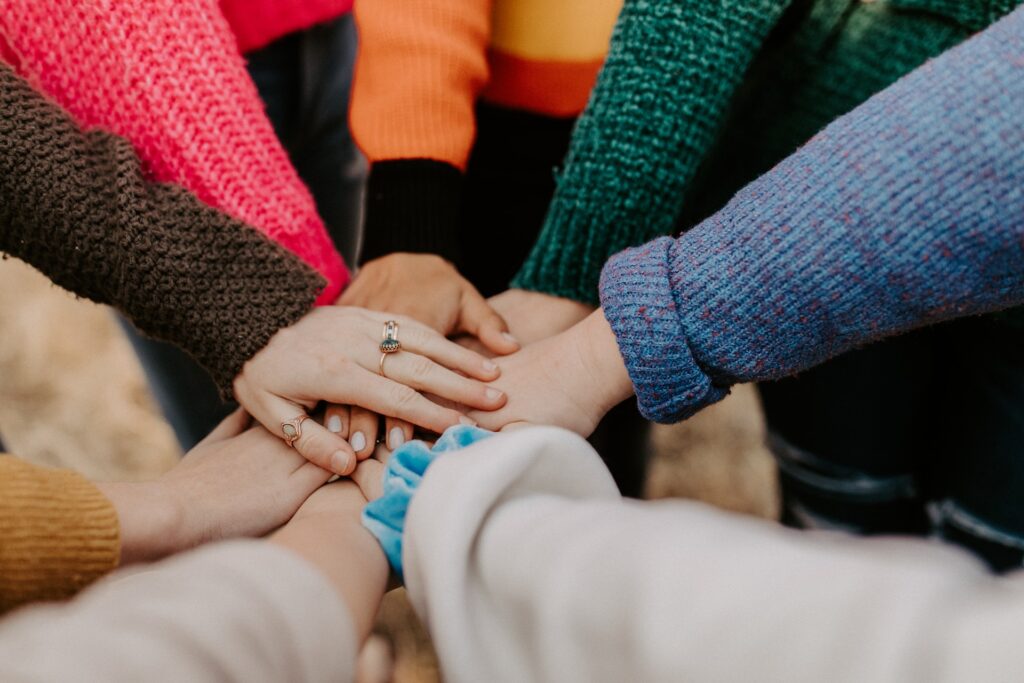Listen, Lift Up, Take Action

IMAGE note – another great example of trying to find stock images that are useful – using every prompt possible for “lifting up”, “intersectional”, etc… – I get this image where there are mostly white hands and white hands cover color. Something so simple, but images matter.
The last parts of Chapter V, “Reconnection”, in Embrace Yoga’s Roots gives us some tools and ways to seek reconnection in yoga spaces and beyond. At its roots, yoga is a practice of transformation and healing of historical and karmic traumas – individually and socially. What we do matters, and all of our action has some reaction in the world that reverberates through time.
“Who we raise up and provide platforms for in our society and how we do that is important…”
Embrace Yogas Roots – pg 155
We are not individuals able to cut ourselves off from what is happening around us. However, as we look at the lists that Susanna Barkataki gives for providing platforms and inviting people in, it can seem impossible to seek inclusion and diversity in certain spaces. On the studio level, Iyengar Yoga, with its lengthy time commitment and study for certification in particular, already suffers a scarcity of yoga teachers and those teachers are a mirror of Western Yoga culture – mainly white and middle class. We live in LaCrosse, WI on top of that – not the most culturally diverse place in the world. However, we DO have diversity in our own ways, and as Susanna pointed out earlier, most places have more color than is seen by the mere fact of social segregation. This is where we have to start to look outside our comfort zones and act outside our usual circles if we are interested in making small strides of change.
This really IS the practice of yoga. Individually, we have to learn to recognize parts of ourselves that have been ignored, dead or inactive for a long time. We have to face and accept some limitations at any one moment, but not let those limitations stifle our practice. We look at our individual Self as an interconnected and diverse universe of many layers, needing different and sometimes seemingly contrary approaches to reconnect. So why not the same approach for social change? When I look at the list for “courageous conversations” on pages 160-162, for me it reads like the approach to yoga practice, we just have to accept that “practice” means off the mat action as well.
- Be Thoughtful, Uplifting and Kind
- Strive to Embody an Ethic of Mutual Growth and Support
- Use Anti-Oppressive Methods and Means
- Solutionary Culture
- Mind-Body Learning
- Hold Room for Multiple Truths (this is one of my favorites)
- Consider Context
How we act then depends on who we are and how we are called. Not any one of us is going to work the same or have the same approach, but that is the beauty of life and yoga. “Across the board, finding where you work best and forming alliances, not enmity, with people who work in different methods and fashions is key.” (pg 163) Alignment in the goal is what is important.
The last part of Chapter V addresses the ideas of “Reparations and Intersectionality”. Giving back and getting creative in our thinking and actions is needed. For Iyengar Yoga teachers, the idea of reparations is and can be easy. At our foundation we have a connection and direct lineage back to India and the root culture of yoga. When we pay dues to our national organization or travel to India to study, we spend money within the culture of yoga. When our Indian teachers are offering class, mostly we flock to them to hear their voices.
Intersectionality I feel is a bit more difficult. Yes, our Iyengar Yoga practice does have its philosophical and cultural roots in the East, and our approach encourages creativity and a multitude of approaches to reach the same goal – Ex: the development of the myriad of props was to open the practice up to every body type and ability. Yet, we still fall into certain Western Yoga habits – perfectionism, individualism, lack of diversity, single narrative, policing and shaming of anything that differs from the norm (pg 77), etc…This clear example of Eastern practice translated through a Western lens is for me such an interesting study. And, it has been such a blessing to be listening to Prashant Iyengar on Saturday mornings while also reading this book. The vast, cyclical, eternal, and very intersectional web of the cosmology of India is truly difficult for the linear, time-bound, compartmentalizing mind of the Westerner to comprehend. Despite that difficulty, it is our work to listen and to embrace the roots of yoga for our Self, our colleagues, and our students.
“We are the ones who are responsible for preserving the heart and soul of this powerful practice for future generations; for ensuring that a full spectrum of yoga is preserved and shared….Satya (truth-telling) isn’t just about your own voice, its about all of our voices. It’s about the voices we dont hear. Its about the voices we’ve all but lost.”
Embrace Yoga’s Roots – pg 175
CHANGE to READING SCHEDULE and “Save the Date” for BOOK DISCUSSION
- Aug 14 – Chapter VI – Liberation
- Aug 21 – Chapter VII – How to Continue this Work
- Sunday, AUG 27 – Discussion and Potluck at 5pm CST – bring a dish to share in studio, hybrid discussion on Zoom will follow